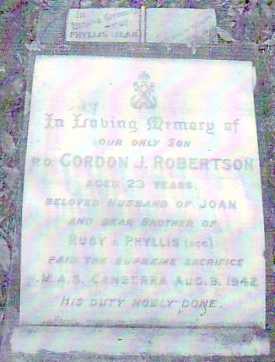- Author
- Swinden, Greg
- Subjects
- Biographies and personal histories
- Tags
-
- RAN Ships
- HMAS Canberra II
- Publication
- September 2007 edition of the Naval Historical Review (all rights reserved)

In the quiet Presbyterian Section of GoreHill Cemetery (Sydney), only 50 metres or so from the busy Pacific Highway upon which the people of the city travel to and from their daily business, stands a headstone commemorating an ordinary Australian sailor. Yet this is no ordinary grave, for it is an empty grave. This memorial commemorates Ordnance Artificer IV Class Gordon Jack Robertson of HMAS Canberra who was killed on 9 August 1942 when the cruiser was sunk at the Battle of Savo Island. His wife and parents commissioned the memorial as Gordon Robertson, like most wartime RAN casualties, has no known grave.
The empty grave (or memorial) is commonplace in Australia and became so during World War I when thousands of Australian soldiers were listed as ‘Missing – Believed Killed in Action’ at Gallipoli, the Middle East and on the Western Front. Families often erected special headstones to their missing loved ones or added their names to family memorials, stating where their son or husband had fallen.
During World War II this form of commemoration again became popular but this time all three services were acknowledged. Thousands of Australian airmen were killed in operations over Europe and the bodies of many were never recovered. During the South East Asian and Pacific campaigns, particularly in 1941-42, hundreds of Australian soldiers were listed as missing in action and later many died as PoWs without a known grave.
For the Navy, the heavy fighting in the Mediterranean and the Pacific Campaigns produced hundreds of casualties, most with no known grave. These losses included the sinking or damage of HMA Ships Goorangi (19 missing), Sydney (645 missing), Parramatta (130 missing), Perth (356 missing), Yarra (138 missing), Vampire (8 missing), Canberra (84 missing), Matafele (24 missing), Australia (17 missing), and Nizam (10 missing). Other ships lost men to enemy action, accidents or the vagaries of the sea and weather and as a result their bodies were either lost overboard or buried at sea.
The sinking of troopships (with Anking, Ceramic, Khedive Ismail, Tulagi and Nellore being the most catastrophic) added yet another 57 to the list of the missing. Thus of the approximately 2,000 RAN personnel listed as fatal casualties during the war, well over 1,500 have no known grave and their names are recorded on the Plymouth Naval Memorial to the missing.
For their families the creation of an individual memorial to them in Australia allowed a place to grieve and offer commemoration. For the Robertson family, the memorial held special significance as the remains of Gordon’s infant sister Phyllis, who died in September 1918, are buried nearby. But what of Gordon Robertson? He was born on 28 July 1919, the second of three children born to Arthur and Barbara Robertson of North Sydney, and joined the RAN on 6 July 1939 as an Ordnance Artificer V Class (Official Number 23389). He enlisted for a period of 12 years (having been a Fitter and Turner in civilian life) and was described on entry as 5 foot 6 inches tall with fair hair, hazel eyes and a fresh complexion, and a scar on his right cheek.
Gordon Robertson’s initial service was `under training’ at HMAS Cerberus and after being rated as an Ordnance Artificer IV Class he joined Canberra on 11 June 1940. Three days before joining Canberra, he married 20 year old Edna Joan Gerrard at St Patrick’s Cathedral in Melbourne (it is not known if they had any children, but following Gordon’s death she remarried and became Mrs Edna Joan Carter).
During 1940 and 1941, Canberra operated on the Australian Station and Indian Ocean escorting convoys and searching for German raiders. In late 1941 and early 1942, she carried out convoy escort duties to New Guinea and Java before becoming part of Task Force 44 which was to become involved in the operations to recapture the Solomon Islands. Ordnance Artificer IV Class Gordon Jack Robertson was still serving in Canberra on the fateful night of 8/9 August 1942 when off Savo Island in the Solomon Islands Group, the ship was badly damaged by enemy action and later sunk. He was subsequently listed as `Presumed Killed’ and Discharged Dead on 9 August 1942.
Lest We Forget.




